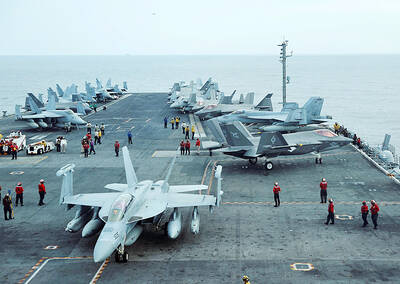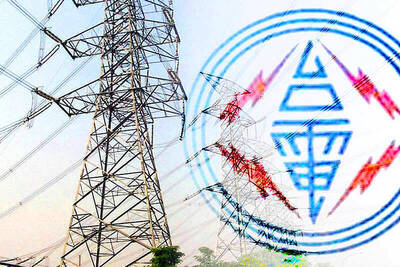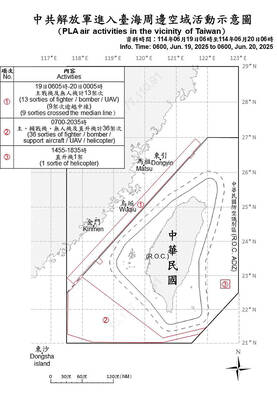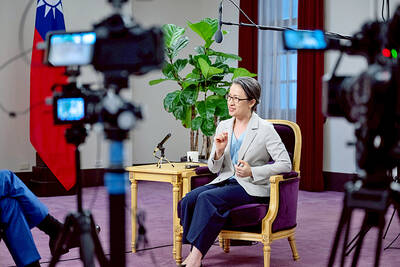Frequently wearing flip-flops might lead to feet and spine injuries, a Taoyuan-based physician has said.
Wearing flip-flops daily could cause one’s toes to become deformed, as well as leading to lower-leg fatigue, sprained ankles and deformed vertebrae, among other conditions, Lin Sung-kai (林頌凱), a sports medicine doctor at Taiwan Landseed Hospital, said in a video he posted on YouTube on Jan. 8.
Flip-flops are designed for short distances — for example, walking on the beach — and their simple design cannot provide the support needed for long distances, he said.
“When people wear flip-flops, they unconsciously change their walking style. They walk faster and take shorter steps. This might cause pain and blisters — and eventually deformation,” Lin said.
Walking in flip-flops also moves a person’s center of gravity forward, which can cause the curve of the spine to change, he said.
“When walking in flip-flops, many people stiffen their toes, which causes fatigue in the lower legs and, over time, increases the risk of tendon inflammation and sprained ankles,” Lin said.
Due to their flat soles, flip-flops cannot support the arch of the foot, which could lead to plantar fasciitis — a painful condition of the foot’s connective tissue, he said.
“Wearing flip-flops for a long time might cause pain in the ankles. People with high arches might feel pain in the heels and the sides of their feet,” Lin said.
Flip-flops should not be worn for more than one hour at a time, and never while doing sports, he said.
Flip-flops or sandals with arch support are preferable, Lin said, adding that uneven surfaces should be avoided while wearing flip-flops.
People with diabetes or problems with their peripheral nerves should never wear flip-flops, as doing so can lead to a heightened risk of injury, he said.

China might accelerate its strategic actions toward Taiwan, the South China Sea and across the first island chain, after the US officially entered a military conflict with Iran, as Beijing would perceive Washington as incapable of fighting a two-front war, a military expert said yesterday. The US’ ongoing conflict with Iran is not merely an act of retaliation or a “delaying tactic,” but a strategic military campaign aimed at dismantling Tehran’s nuclear capabilities and reshaping the regional order in the Middle East, said National Defense University distinguished adjunct lecturer Holmes Liao (廖宏祥), former McDonnell Douglas Aerospace representative in Taiwan. If

TO BE APPEALED: The environment ministry said coal reduction goals had to be reached within two months, which was against the principle of legitimate expectation The Taipei High Administrative Court on Thursday ruled in favor of the Taichung Environmental Protection Bureau in its administrative litigation against the Ministry of Environment for the rescission of a NT$18 million fine (US$609,570) imposed by the bureau on the Taichung Power Plant in 2019 for alleged excess coal power generation. The bureau in November 2019 revised what it said was a “slip of the pen” in the text of the operating permit granted to the plant — which is run by Taiwan Power Co (Taipower) — in October 2017. The permit originally read: “reduce coal use by 40 percent from Jan.

‘SPEY’ REACTION: Beijing said its Eastern Theater Command ‘organized troops to monitor and guard the entire process’ of a Taiwan Strait transit China sent 74 warplanes toward Taiwan between late Thursday and early yesterday, 61 of which crossed the median line in the Taiwan Strait. It was not clear why so many planes were scrambled, said the Ministry of National Defense, which tabulated the flights. The aircraft were sent in two separate tranches, the ministry said. The Ministry of Foreign Affairs on Thursday “confirmed and welcomed” a transit by the British Royal Navy’s HMS Spey, a River-class offshore patrol vessel, through the Taiwan Strait a day earlier. The ship’s transit “once again [reaffirmed the Strait’s] status as international waters,” the foreign ministry said. “Such transits by

Taiwan is doing everything it can to prevent a military conflict with China, including building up asymmetric defense capabilities and fortifying public resilience, Vice President Hsiao Bi-khim (蕭美琴) said in a recent interview. “Everything we are doing is to prevent a conflict from happening, whether it is 2027 or before that or beyond that,” Hsiao told American podcaster Shawn Ryan of the Shawn Ryan Show. She was referring to a timeline cited by several US military and intelligence officials, who said Chinese President Xi Jinping (習近平) had instructed the Chinese People’s Liberation Army to be ready to take military action against Taiwan